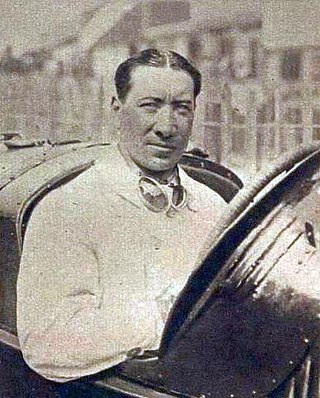Grand Prix motor racing, a form of motorsport competition, has its roots in organised automobile racing that began in France as early as 1894. It quickly evolved from simple road races from one town to the next, to endurance tests for car and driver. Innovation and the drive of competition soon saw speeds exceeding 100 miles per hour (160 km/h), but because early races took place on open roads, accidents occurred frequently, resulting in deaths both of drivers and of spectators. A common abbreviation used for Grand Prix racing is "GP" or "GP racing".

The Czechoslovakian Grand Prix was a Grand Prix motor racing event held in 1949 at the Masaryk Circuit now referred to as the Brno Circuit. It was held in the town of Brno in Czechoslovakia.

The Tripoli Grand Prix was a motor racing event first held in 1925 on a racing circuit outside Tripoli, the capital of what was then Italian Tripolitania, now Libya. It lasted until 1940.

Richard John Beattie Seaman was a British Grand Prix racing driver. He drove for the Mercedes-Benz team from 1937 to 1939 in the Mercedes-Benz W125 and W154 cars, winning the 1938 German Grand Prix. He died of his injuries after his car overturned at the 1939 Belgian Grand Prix.

Count Gastone Brilli-Peri was an Italian racing driver, who won the 1925 Italian Grand Prix in an Alfa Romeo P2, securing the inaugural World Manufacturers' Championship title for Alfa Romeo. Known simply as "Brilli", his face had been permanently scarred in an accident during a Tour of Italy motorcycle race. He used to race wearing a hat similar to a Basque beret, which is now known in Italy as a brilliperi.

Autodrome de Montlhéry is a motor racing circuit, officially called L’autodrome de Linas-Montlhéry, owned by Utac, located south-west of the small town of Montlhéry about 30 km (19 mi) south of Paris.

Louis Auguste Wagner was a French racing driver who won the American Grand Prize and the inaugural British Grand Prix. Wagner was also a pioneer aviator.

The 1939 Swiss Grand Prix was a motor race held at Bremgarten on 20 August 1939.
The 1925 Grand Prix season was a watershed year in motor racing. It was the first year for the new AIACR World Manufacturers' Championship season. The championship was won by Alfa Romeo, with its P2 model.

The 1908 Grand Prix season was the third Grand Prix racing season. An international economic recession affected motor-racing with fewer races and smaller fields. However, in consequence, it also saw an increase in the number of smaller cars and voiturette racing. This gave close racing between the teams from Lion-Peugeot, Sizaire-Naudin and Delage. Both the major races in Europe, the Targa Florio and French Grand Prix, had precursor voiturette races, and along with the Coupe des Voiturettes, the honours were shared between those three manufacturers. This year’s Targa Florio had a small, but quality, field. Vincenzo Trucco won for Isotta-Fraschini with better mechanical reliability, after a close duel with the FIATs of Felice Nazzaro and Vincenzo Lancia.
The 1910 Grand Prix season was the fifth Grand Prix racing season. Because of the ongoing international economic recession, there were no Grandes Épreuves held. The American Grand Prize was held in Savannah.
The Circuit des Ardennes was an auto race held annually at the Circuit de Bastogne, Bastogne, from 1902 to 1907. It was the first major race to run on a closed course instead of from one city to another. The name was later used for a rally, part of the Dutch as well as the Belgian national rally championships.

The 1909 Grand Prix season was the fourth Grand Prix racing season. There were no Grandes Épreuves that year, as the economic recession of the previous year continued on. Renault had withdrawn from motor-racing and a number of French manufacturers, falling behind the success of their German and Italian rivals, followed suit. The French Grand Prix was cancelled, leaving the Targa Florio in Italy and Vanderbilt Cup in the United States as the only major races this season. With so little competition and financial incentive, technological advances ground to a halt. Emphasis shifted from racing to setting speed and endurance records. Benz & Cie built a new 12.4-litre racing-engine, and its 200 bhp derivative was put into the Blitzen Benz. This 21.5-litre monster held the Land speed record from 1909 to 1922, with various drivers starting with Victor Hémery in November, 1909 at Brooklands.

The Historic Grand Prix of Monaco is a series of automotive races focussed on historic motorsport. The event is typically held biennially two weeks before the Formula One Grand Prix of Monaco.

The 1934 Swiss Grand Prix was a Grand Prix motor race run to the 750 kg formula, held over 70 laps of Circuit Bremgarten, near Bern, on 26 August 1934. It was supported earlier in the day by the voiturette-class Prix de Berne, held over 15 laps of the same circuit. The main event was won by Hans Stuck in an Auto Union, who led the race from the start. While Stuck's pole position had been earned by setting the fastest lap time in practice, starting positions following the German were decided by ballot. The voiturette race was won by Dick Seaman driving an MG, having started from the ninth row of the grid. The meeting was marred by the fatal accident of British driver Hugh Hamilton on the final lap of the Grand Prix.
Alfa Romeo Tipo 316, 316 or 16C-316 Grand prix car was used in Grand Prix seasons 1938 and 1939, when it was driven by Giuseppe Farina and Clemente Biondetti. The Tipo 316 was one of three Alfa Romeo cars designed for the new rules in 1938, which differed mainly by the engine, the other two were the Alfa Romeo Tipo 308 straight-8 and Alfa Romeo Tipo 312 with a V12 engine. The car was based on Alfa Romeo 12C-37. It had roots supercharged 60 degree engine from 2,958 cc (180.5 cu in) capacity 58 mm × 70 mm produced 350 bhp (261 kW) at 7500 rpm. The engine was more powerful than the one in Tipo 308 or 312, but it was still not really competitive against Germans.
Luigi "Gigi" Platé was an Italian racing driver.

The 1932 Tunis Grand Prix was a Grand Prix motor race held at the Carthage Street Circuit in Tunis, the capital of colonial Tunisia, on 17 April 1932. Achille Varzi, in a privateer Bugatti, won the 37-lap race ahead of fellow Bugatti driver Marcel Lehoux, with Philippe Étancelin, in an Alfa Romeo, claiming third position. The leading drivers in the voiturette class were Louis Joly, Pierre Veyron and Luigi Castelbarco.

The Circuito di Ospedaletti commonly known as the Ospedaletti Circuit was a motor racing road course in the north-western coastal town of Ospedaletti, active from 1947 to 1972.
The Junior Car Club 200 Mile race was a voiturette and later Grand Prix motor race, first held in 1921. It was held on various layouts of Brooklands, and twice at Donington Park.












